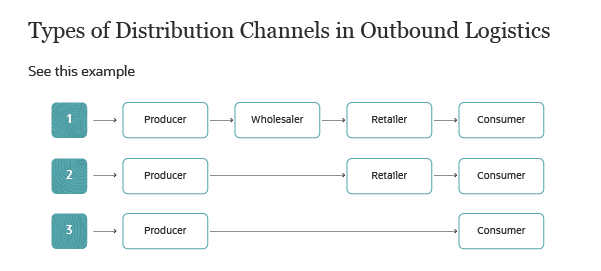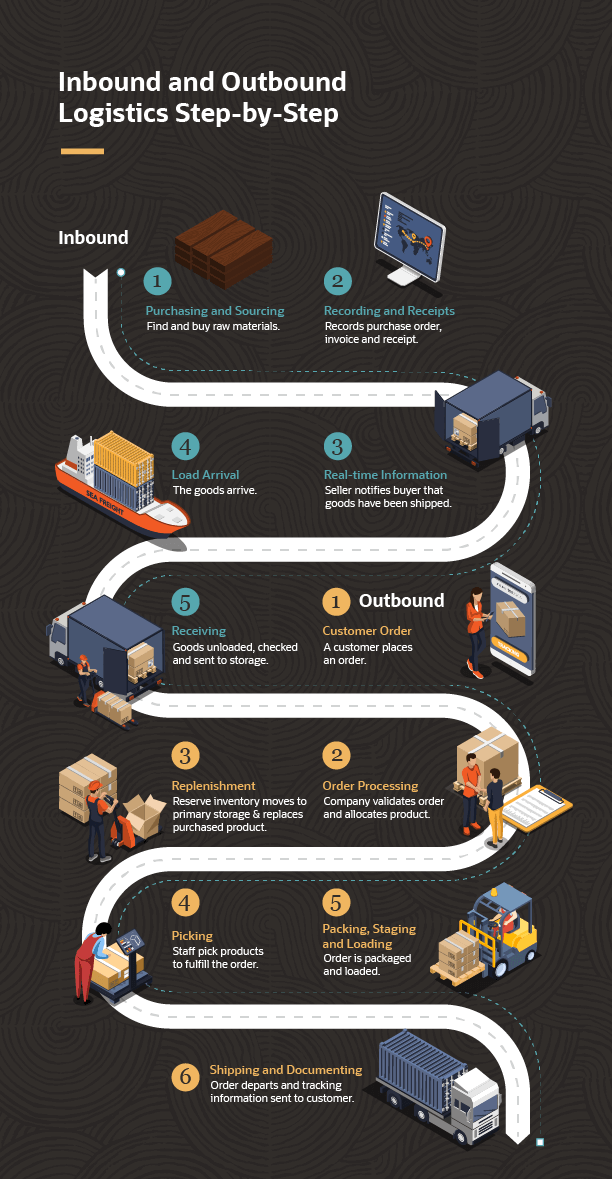Strong inbound and outbound logistics are crucial to the success of a business. These processes affect production, profits and customer service. There are many challenges in getting logistics right, and the costs of not perfecting these processes can be enormous. But putting the right controls in place can help your business achieve success.
In this article:
- Step-by-step breakdowns of inbound/outbound logistic processes
- Examples of inbound/outbound logistics
- Why inbound and outbound logistics are critical to running a profitable business
What Is Logistics?
Logistics coordinates the movement and storage of resources such as goods, equipment and inventory. For manufacturers, logistics starts with the incoming supply of raw materials and carries through to the delivery of finished products to customers.
For example, a logistics department would receive supplies, give components to a production line, move finished goods to a distribution centre, manage inventory and ship products to a customer.
Logistics teams are responsible for making sure each of these steps run smoothly, including purchasing, accepting inbound delivery, storage, packaging, inventory management, shipping, outbound transportation and delivery. Choreographing these processes gets complicated when volume grows and there are multiple products to manage. Companies that use several distribution channels and operate facilities in different locations face another layer of complexity.
In 2020, the Transport and Logistics sector in Australia earned $101.51 billion and contributed $39.91 billion to Australia’s GDP and the Asia e-commerce logistics market is set to account for 57% of total global market growth from 2020 to 2025. To generate the best returns, a company needs to have the right supplies at the right place at the right time. Its manufacturing line cannot run unless it has all the necessary materials to build its product or items to distribute in the requested amounts. If the company does not have enough stock to fill an order, it may lose a sale or make a customer unhappy by forcing them to wait for the item.
Role of Logistics
Logistics is the foundation of the supply chain and is vital to a company’s success. Well-organised logistics can reduce expenses, save time, help meet customer demands and enhance a brand’s reputation.
Effective logistics is key to managing the supply chain, the complex network of organisations, individuals, activities and resources required to supply a service or product.
What Is the Difference Between Inbound and Outbound Logistics?
Inbound logistics brings supplies or materials into a business, while outbound logistics deals with moving goods and products out to customers. Both focus heavily on the transporting of goods. But inbound is all about receiving, while outbound focuses on delivery.
Inbound vs. Outbound Logistics
| ATTRIBUTE | INBOUND LOGISTICS | OUTBOUND LOGISTICS |
|---|---|---|
| Direction | Inward | Outward |
| Focus | Supply | Demand |
| Role | Receiving | Delivery |
| Key Relationships | Suppliers, vendors and their distributors | Distributors, wholesalers, retailers, end customers |
| Processes | Sourcing, procurement, materials handling, putaway | Inventory management, order fulfillment, shipping |
| Activity | Raw materials or goods coming in from suppliers | Finished products going out to customers |
| Strategic Imperative | Obtaining goods or materials the company needs to make its products | Meeting customer demand, supporting the sales process to generate revenue |
What Is Inbound Logistics?
Inbound logistics is the way materials and other goods are brought into a company. This process includes the steps to order, receive, store, transport and manage incoming supplies. Inbound logistics focuses on the supply part of the supply-demand equation.
Inbound Logistics Activities
- Sourcing and procurement: Identifying and evaluating potential suppliers, obtaining price quotes, negotiating with and managing suppliers.
- Ordering/purchasing: Buying the goods and materials the company needs so the right quantity arrives at the right time.
- Transportation: Deciding whether to use a truck, airplane, train or another method to move goods. This activity also involves selecting delivery speed for incoming supplies, contracting with third-party carriers and working with vendors on price and route.
- Receiving: Handling the arrival of new materials, unloading trucks and ensuring they match the order.
- Material handling: Moving the received goods short distances within the facility and staging them for later use.
- Putaway: Moving goods from the receiving dock to storage. Staff puts everything away in assigned locations.
- Storing and warehousing: Managing the materials before they go to manufacturing or customer fulfillment. This department is responsible for making sure items are placed in logical locations for fulfillment and the right storage conditions are met.
- Inventory management: Deciding the type and amount of raw materials/items you should store and where to locate them. Read the inventory management guide to learn more.
- Expediting: Managing the progress of and schedule for materials as they make their way to your facility.
- Distribution: Sending supplies to their destination inside the business.
- Tracking: Checking on details about incoming orders, such as their location and documents like receipts.
- Reverse logistics: Bringing goods back from customers for reasons such as returns, defects, delivery problems, repair and refurbishment. Also, recycling and salvage firms that work with used materials obtain their supply through reverse logistics.
How a company approaches inbound logistics varies depending on incoming goods, the industry and the buyer-seller relationship. The company may handle its own inbound logistics or outsource it.
Challenges of Inbound Logistics
The primary challenges of inbound logistics are high costs, uncertain delivery dates and unpredictable lead times. These make it hard for businesses to maintain ideal inventory levels and improve warehouse efficiency and productivity.
Here are some specific inbound logistics challenges in more detail:
-
Inbound shipping inefficiencies: Some companies spend too much of their budget on shipping. To cut costs, you need to negotiate preferred rates with fewer carriers and consolidate inbound shipments to make full truckloads. You can also set vendor inbound compliance standards (VICS) on price and service. Analytics can help you identify any waste of time or money.
-
Information vacuum: One frequent challenge is not knowing the exact location of a shipment, when it will arrive and how much it will cost. This lack of knowledge causes some companies to carry extra inventory, make purchases too early and suffer delays in production and customer deliveries. Real-time information systems allow a company to track and trace shipments and communicate with suppliers to make sure accurate data is captured when entering materials.
-
Surges in deliveries and receiving: Without proper planning, businesses can end up juggling too many deliveries simultaneously. As a result, their yards become clogged with trucks, causing confusion among drivers about which dock to use. Peaks and lulls in deliveries makes it hard to effectively staff receiving personnel, as well. A weak receiving process leads to errors and a backup of materials. Solutions include scheduling arrivals, routing deliveries to specific docks and maintaining a consistent pace throughout the day. Warehouse management software (WMS) can help with logistics. Another technique is cross-docking, where the receiving department matches incoming inventory to open orders. When workers unload products, they move them directly to another dock to load onto an outbound truck, without ever storing them.
-
Processing returns: Returns processing is an afterthought for some companies, leading to lost sales when stock is not put back into inventory quickly. Inaccurate inventory counts and reduced customer satisfaction are additional problems. Create clear, efficient processes for returns and communicate the importance of returns management to staff to combat this issue.
-
Supplier reliability: A company needs dependable suppliers that offer competitive pricing and quality. However, reliable suppliers can be difficult to find and keep. To make this easier, try steps such as:
- Build long-term relationships
- Pay suppliers on time
- Negotiate as necessary to make sure contracts align with your business goals
- Check supplier quality certifications
- Evaluate supplier risks such as political climate, weather and labour relations
- Forecast your growth patterns and pick suppliers that can scale
- Check supplier lead time and on-time delivery rate
- Assess their customer service
- Consistently evaluate alternative suppliers
-
Balancing supply and demand: Ensuring there are enough incoming supplies to meet customer demand can be difficult due to seasonality, competitive influences, economic conditions, pricing volatility in raw materials, fluctuations in selling cycles and more. The best way to balance supply and demand is through data. Software can compare incoming inventory to your order pipeline. It can also monitor the status and location of inbound deliveries, predict demand based on historical patterns, find opportunities to consolidate purchases and more.
How to Optimise Your Inbound Logistics
Optimising inbound logistics means making the operation faster, leaner, more cost-efficient and more agile. Assess every process, identify strengths and weaknesses, and then make improvements.
-
Model your current process and measure performance.
Look for inefficiencies related to cost, waste, quality loss, duplicate work, information gaps and delays. The presence of invisible or intangible costs in inbound logistics, such as inventory carrying costs and the impact of poor customer service, can complicate matters. Compare your operation to industry benchmarks and competitors. -
Analyse your choices.
Understand how your decisions affect cost and efficiency. For example, if the procurement department makes purchases in large quantities to receive volume discounts, are those savings offset by the expense of holding and managing excess inventory? The major cost drivers for inbound logistics are purchasing, supplier management, transportation, receiving, warehousing, material handling and inventory management. -
Develop strategies to address inefficiencies system-wide.
Account for trade-offs among activities. Investing in automation and analytics will enable more data-driven decision-making.
Some of the most widely recommended actions to optimise inbound logistics include:
-
Build strong relationships with suppliers: Strong supplier partnerships can yield benefits such as better terms, reduced lead time, cost savings and a sense of security during market fluctuations.
Prioritising this relationship helps your supplier understand your business better. A supplier compliance plan explains your requirements and penalties for mistakes such as late delivery or not following route guidelines. Such a program can reduce freight and warehouse costs, improve speed and accuracy, and increase customer satisfaction. -
Use a transportation management system (TMS): This software automates, manages and optimises freight operations. A TMS compares shipping quotes and service levels among carriers, schedules the shipment and tracks it through delivery. These details help a company reduce costs, increase efficiency and gain full visibility into its supply chain.
-
Use a warehouse management system (WMS): WMS software optimises warehouse operations by streamlining receiving, putaway, inventory management, picking and more.
-
Combine deliveries: Less-than-truckload (LTL) shipments have higher shipping costs and longer receiving times. Sometimes there are barriers to consolidating shipments, such as different handling needs (some goods need refrigeration, for example). If a business struggles to make full truckloads, a third-party logistics provider (3PL) can combine its partial loads with those of other customers.
Video: What Is Inbound Logistics & How to Optimise It
What Is Outbound Logistics?
Outbound logistics focuses on the demand side of the supply-demand equation. The process involves storing and moving goods to the customer or end user. The steps include order fulfillment, packing, shipping, delivery and customer service related to delivery.
Outbound Logistics Activities
-
Warehouse and Storage Management: A company keeps a certain quantity of goods on hand to meet demand. Outbound logistics processes store these goods securely in the right conditions and organise them. Inbound and outbound logistics overlap in warehouse management. But outbound logistics deals with outgoing finished products. For companies that sell finished products they receive from suppliers, inbound logistics concentrates on product acquisition and outbound logistics fulfills orders sent straight to customers and distributes the products to retail outlets.
-
Inventory Management: Software often plays a central role in inventory management, a process that determines the best place to store goods in the warehouse for fast order fulfillment and the order picking and packing operation. Inventory management goals include inventory and order accuracy as well as maintaining product quality by preventing damage, theft, obsolescence or spoilage.
-
Transportation: The modes and methods of shipping products vary depending on the type of goods. For example, huge items like heavy machinery may ship in small order quantities by truck. Perishable items like fresh flowers may need to be transported by plane in refrigerated containers.
-
Delivery: On-time delivery is critical to success. Moreover, the customer’s order must have the correct items and quantities, and the package can’t get lost or damaged in transit. Outbound logistics takes responsibility for this step.
-
Distribution Channels: The ways your product reaches the customer, called distribution channels, affect how you organise outbound logistics. Distribution channels can be broadly categorised into direct (when you sell directly to your customers) and indirect (when you sell through an intermediary such as a wholesaler or retailer). There are many distribution methods, including direct to consumer, value-added resellers, dealer networks, dual-distribution, omnichannel and drop shipping. When choosing distribution channels, consider logistics complexity, cost, speed, quality, customer satisfaction and control.

-
-
Last-mile Delivery: The final step in an order’s journey covers the last shipping leg and delivery. The last mile is usually the most costly and inefficient part of delivery. The term comes from the early days of telephone service, when wiring homes to the mainline was slow and expensive. Last-mile logistics includes services such as home grocery delivery from a local store and package delivery by a common carrier. Before the last mile, shippers can handle lots of orders at the same time in the same way (for example, they can load dozens of orders going to the same city in one truck). But in the last mile, each delivery requires individual handling because it goes to a single address. Deliveries to addresses get spread over a suburban region or packed within a gridlocked city centre where parking is difficult. The global last mile delivery market size was valued at SG$25.1b in 2020, and it is expected to reach US$84.2 Bn by 2027. The APAC region accounted for 19% of the market share in 2020 and is expected to show the highest growth during the forecast period.
-
Delivery Optimisation: Optimising delivery involves not only reducing costs but meeting ever-increasing customer expectations for speed and visibility. Often, these two things go hand-in-hand. Route planning software groups orders more efficiently for delivery, sorts packages by route, plots the best course with an eye to traffic, fuel consumption and other variables, and assigns routes to drivers.
Challenges of Outbound Logistics and How to Overcome Them
Outbound logistics challenges can hurt profits and customer satisfaction. Inventory and shipping costs can rise quickly, while incorrect or late orders will drive customers away.
These are some specific outbound logistics challenges:
- Coordinating Operations: Outbound logistics teams must monitor production, storage and distribution—coordinating the optimal movement of goods is no small task. If production rises, the logistics team needs to free up more warehouse space, and as production increases to meet customer demand, shipping and delivery need to scale. Software and automation can help close the information loop by connecting production to storage capacity and demand.
- Achieving the Seven Rs: Coined by John J. Coyle, professor emeritus of logistics and supply chain management at Penn State University, the seven Rs are: getting the right product, to the right customer, in the right quantity, in the right condition, at the right place, the right time and at the right cost. Consistently hitting these targets requires an integrated management process that uses data to assess performance, identify areas of weakness, and track and foster continuous improvement.
- Inventory Costs: Keeping enough inventory to meet fluctuating customer demand without creating unnecessary holding costs requires careful planning. Keeping a close eye on inventory planning metrics such as sell-through rate and inventory turnover and tracking numbers like safety stock and shifts in demand is important. See the comprehensive list of inventory management metrics for a list of key formulas.
- Transportation Costs: A major cost for outbound logistics is transportation. Companies can control costs by analysing past spending to spot inefficiencies. Try exploring different strategies such as dynamic pricing, volume discounts with carriers, opening up bidding for your products/services and looking at freight marketplaces.
- Rising Customer Expectations: Consumer demands continue to climb, and free, fast delivery is now the expectation. Same-day and even two-hour delivery are the norms in some regions and industries. Customers want real-time visibility into the status of their orders and to be able to track them on a map. To meet this trend, logistics teams need to understand the role of delivery as a competitive differentiator and the lasting effect of a poor customer delivery experience.
How to Optimise Your Outbound Logistics
To optimise outbound logistics, put effort into relationships and negotiations. Use technology to figure out delivery networks, plan routes, organise schedules and, ultimately, keep costs down.
-
Understand when fast delivery starts.
To meet carrier requirements for fast shipping, you may need to set up product staging at distribution centres, sort shipments according to distribution centre guidelines and tailor packaging to meet their requirements. In some industries, like wholesale food supply, a distribution centre may employ a lumper service, which uses third-party workers to load or unload trailers. The aim is to speed up turnaround and let the truck driver rest and depart faster. You need to know whether the distribution centre will use lumping so you can account for these extra costs. -
Adapt to current inventory strategies.
Just-in-time (JIT) inventory and other rapid replenishment methods mean that large orders delivered to customers at widely spaced intervals are no longer the norm. Most customers using JIT will not have room to store a lot of excess product, so you need to adapt your outbound logistics to mesh with these inventory trends. You may need to account for more LTL orders. -
Build and improve partner relationships.
Work closely with key partners in outbound logistics, including your customers and freight providers. Depending on your industry, you may sell to major retailers that have deep insights into their complex supply chains. With the right relationship, they may share data on how your product is selling so you can fine-tune your production, order fulfillment and shipping. By working closely with freight carriers, you can learn if dividing your business among just a few shippers gives you more control over price and service level agreements. -
Use smart route planning.
Automated route planning can reduce waiting and travel time for deliveries. The time savings can cut fuel costs and boost customer satisfaction. -
Investigate 3PL as an alternative.
For many companies, the cost and complexity of outbound logistics can make outsourcing to a 3PL a smart move. The size of 3PLs gives them volume discounts and negotiating leverage, which can lead to cost savings for you. 3PLs bring expertise, specialisation and the opportunity to quickly scale your operation up or down depending on business needs.
Inbound and Outbound Logistics as Part of Supply Chain Management (SCM)
Logistics is just one piece of supply chain management. Supply chain management manages all the links among suppliers, producers, distributors and customers.
Other elements of supply chain management include manufacturing and delivery-related customer service. Logistics helps synchronise the supply chain by controlling the flow of goods from the point of origin to the point of consumption. Participants in the supply chain, like suppliers and buyers, find partnerships helpful. Two firms work together for their mutual benefit. These partnerships are often open-ended, unlike strategic alliances or project partnerships.
Supply chain partnerships require:
- Frequent and open two-way communication
- Cooperation on accurate, efficient order execution
- Coordinated decision-making
- Sharing of resources
- Information and knowledge exchange
The most important partnerships include suppliers and vendors on the supply side. On the demand side, the critical ties are among logistics providers, retailers, wholesalers, distributors and end customers.
Suppliers may collaborate closely with important customers on product formulation, product size, product mix, SKUs, inventory levels, supply forecasts, risk management, cost control, waste reduction and ordering systems. The customer may want to work together with logistics providers on pacing, packaging, scheduling and route efficiency.
Damage Liability in Logistics
Damage liability for goods lost and damaged while in transit or storage is one area of disputes in logistics. Inventory represents a big cost for businesses, and buyers want protection against losses while goods are in the supplier’s control. Suppliers also want to limit liability.
As a result, the contracts often state how to store and transport materials. Details cover temperature, length of storage, shipping labels and other conditions. Contracts spell out needs for special handling, such as protective packaging or having a particular end standing up. They also address if it is acceptable to stack boxes or store goods underneath heavy items.
To prevent losses, the customer will ask the supplier to track the location of the goods and confirm the correct quantity. If it’s feasible, the customer may want to double-check by visiting the supplier’s warehouse and perform inbound quality inspection if it hasn’t been inspected before it leaves the vendor. Some materials may not need to be inspected, such as low-cost and maintenance, repair & operation supplies (MRO), but the quality department should provide the warehouse with instructions for sampling, inspecting and rejecting failed materials.
The two sides use formulas for damage compensation based on actual value or a set amount per pound. The supplier or customer may get insurance to cover this risk, and both parties may both agree to share the risk by each obtaining partial insurance coverage.
Supply Chain Management vs. Logistics
Supply chain management looks collectively at multiple business activities to achieve a competitive advantage. Logistics focuses on the flow of goods to meet customer needs.
Role of Logistics in Purchasing and Receiving
Purchasing/Selling Receiving/Shipping
| Diagram showing the relationship between purchasing and selling and receiving and shipping: | ||||||
|---|---|---|---|---|---|---|
| Purchasing | → | Brings materials into the business to meet its needs | → | Selling | → | Moves goods out of the business, satisfying customer’s needs |
| Receiving | → | Accepts and handles incoming supply of raw materials or goods | → | Shipping | → | Packages and transports outgoing product |
Step-by-Step Inbound and Outbound Logistics Processes
Inbound and outbound logistics break down into many specific steps. Together, the steps help ensure the smooth movement of goods and materials into and out of a business.

Steps in Inbound Logistics (Receiving)
-
Purchasing and Sourcing
The company finds vendors that provide the goods it needs, negotiates a price and buys the materials. -
Recording and Receipts
The company records the purchase order and receives a receipt once it makes payment. -
Notification
When the supplier ships the materials, it electronically notifies the company and provides tracking information for the shipment. -
Load Arrival
The goods arrive at the company’s facility, pulling into the dock assigned by the business. -
Receiving
Workers unload the incoming supplies, scan barcodes to count and identify the product. They verify the quantity and condition against the purchase order and confirm acceptance. Goods then move to their next location—manufacturing inventory at a factory, putaway at a warehouse or a staging point for cross-docking. -
Reverse Logistics
The receiving team handles products sent back from customers for returns and repair.
Steps in Outbound Logistics (Shipping)
-
Customer Order
A customer places an order through one of the channels where a company sells its offerings. -
Order Processing
The company validates the order, receives the requested quantity and products from inventory and produces documentation. -
Replenishment
Reserve inventory moves to primary storage, replacing the purchased product. This process may trigger the production of more goods or ordering of raw materials from suppliers to maintain adequate inventory levels. -
Picking
Warehouse workers pick products from storage to fulfill the order. -
Packing, Staging and Loading
Staff packages, labels and documents the order according to internal and customer needs. Workers sort orders according to shipping mode, delivery speed or destination. The team loads the orders onto outgoing trucks. -
Shipping and Documenting
The order leaves the warehouse for distribution centres or partners. The company’s system logs the shipment and sends the customer tracking details. -
Last Mile Delivery
The order is delivered from the distribution centre to the customer. This can be the most expensive—and most important—step.
Examples of Inbound and Outbound Logistics
Every business that makes a product or provides a service has to figure out how to manage logistics. For example, a company that turns silicon into computer chips or a farmer who grows wheat from seeds both use logistics to get goods to their customers.
Inbound Logistics Example
A company’s inbound and outbound logistics depend on what it is selling and its business model. An example can show how these processes work. Here is how logistics work for an apparel manufacturer called Sorina Designs.
-
Purchasing and sourcing: Sorina Designs identifies how much fabric, thread, buttons, zippers and other supplies it needs to make its upcoming fall fashion line to meet forecasted sales volume. The procurement team works with the designers to find vendors for each component that meet Sorina’s needs for price, color, style, quantity and delivery date. The purchasing manager negotiates contracts with each vendor.
-
Recording and receipts: A procurement clerk generates purchase orders, sends these to suppliers, logs the purchase orders and matches them with invoices and receipts.
-
Notification: The vendors send electronic order acknowledgments along with shipment and tracking information.
-
Load Arrival: Trucks carrying the supplies arrive at Sorina Designs’ facility.
-
Receiving: Sorina’s receiving staff unloads the incoming materials, scanning barcodes or RFID tags to count and identify the products. They verify the quantity and condition against the purchase order. The materials move to the warehouse, where they are ready to be manufactured into clothing.
-
Reverse logistics: The receiving team also handles the return of unsold clothing from retailers. Their contracts dictate that stores send back leftover inventory and receive partial credit toward purchases of new season merchandise. Last-season apparel goes to a staging area for use by the team that fulfills orders from discount stores and liquidators.
Outbound Logistics Example
-
Customer order: A national boutique chain, Picture Perfect, has 37 stores. The company orders a collection of women’s pants, blazers, skirts, blouses, dresses and scarves in various quantities in women’s sizes 0 to 18 on Sorina’s website. Picture Perfect uses internal data about shopper preferences, past sales and trend forecasts to decide the quantities of each product and size to purchase.
Sorina’s staff needs to pay close attention to the order’s details because of the variations in patterns (paisley and chevron), colors (burgundy and blue) and sizes. Sending the wrong item or quantity can result customer complaints and lost sales for products that did not arrive in time for seasonal shopping.
-
Order processing: Sorina’s order processing team checks Picture Perfect’s order by confirming Sorina has the right number, sizes, garment types and colors available. They send an order confirmation to Picture Perfect. Sorina’s inventory management system allocates these items so the clothes are no longer available for sale to anyone else. The system sends an order manifest and picking tickets to the warehouse.
-
Replenishment: Workers move clothing from remote storage to the shipping warehouse to replace purchased product as necessary. Sorina’s planners note that a particular blazer is selling faster than expected and ask the garment makers to sew more.
-
Picking: Warehouse staff uses a zone strategy to pick garments for multiple orders. Workers hang Picture Perfect’s blouses, for example, on electric garment racks along with blouses that are part of orders from two other retailers. They use barcodes to distinguish the orders.
-
Packing, staging and loading: All the clothing items in Picture Perfect’s order come together at the packing station. A staff member scans barcodes on the hangers to confirm the order is correct. Packers box the order with tissue, so the garments do not wrinkle. They put boxes together on pallets, shrink wrap the pallets and affix destination and manifest labels.
The packers split Picture Perfect’s order into two batches, one for its distribution centre in the West and the other for its distribution centre in the East. Each one joins other orders heading in the same direction with similar service levels. Picture Perfect’s order will travel by ground shipping since they’re not rush shipments. Workers load the pallets onto outgoing trucks.
-
Shipping and documenting: The order departs. Sorina’s system logs the shipment and sends tracking information to Picture Perfect’s purchasing department. Sorina’s system also sends arrival information to the chain’s distribution centres.
Importance of Inbound and Outbound Logistics
Inbound and outbound logistics are important because they help a business run smoothly. They also have a direct and substantial impact on sales, costs, profits and customer satisfaction.
Below are some of the ways that logistics play a crucial role for companies:
- Control the flow of goods in and out of the business
- Maximise production and sales revenue
- Contribute to customer satisfaction, brand reputation and loyalty
- Influence profitability and ROI
- Help the company make the best use of its money and time
- Provide a competitive advantage when done well
- Contribute to inventory management and can reduce inventory costs
- Reduce wasted raw materials, damage and product returns
- Aid in warehouse management
- Increase order accuracy and delivery speed
Benefits of Inbound Logistics
Companies can take advantage of many benefits from inbound logistics, including more reliable sources of supplies and lower costs for raw materials.
The following are more benefits of efficient inbound logistics:
- Predictable raw material costs
- Higher product quality
- On-time deliveries
- Steady production rates
- Lower costs for shipping and receiving
- Better inventory management
- Ability to spot supply chain problems
- Foundation for sales success
- Stronger vendor relationships
Benefits of Outbound Logistics
Outbound logistics help companies please customers. The process confirms nothing is missing, broken or defective.
Among the specific benefits of well-run outbound logistics are:
- Faster deliveries
- Fewer order cancellations
- More on-time deliveries
- Reduced delivery failures or mistakes
- Less damage and loss in transit
- Lower costs for your company and the customer
- Decreased returns
- Higher customer satisfaction and loyalty
- Stronger company reputation
- Better business planning
Managing Inbound and Outbound Logistics With Software
Inbound and outbound logistics help you meet customer needs by delivering quality, service and timeliness. Software systems put you in control with manufacturing, inventory and warehouse management solutions.
With both inbound and outbound logistics management software running on the ERP platform managing core financial processes, product-based businesses have visibility into all aspects of operations and can quickly and easily run reports that demonstrate the impact of different scenarios on profits, customer satisfaction and more.
Both inbound and outbound logistics can be a major cost centre, but that also means they represent an opportunity for major time and cost savings. That’s why companies should take a close look at these aspects of their operations and see if there are more efficient, cost-effective ways to complete these steps. It’s a key part of optimising supply chain management as a whole and providing the exceptional customer experience that will help your business excel.
Award Winning
Cloud Inventory
Inbound and Outbound Logistics FAQs
Keep expanding your knowledge of inbound and outbound logistics as the field continuously evolves. Here are some of the most common questions.
What is inbound logistics and manufacturing?
In manufacturing, inbound logistics is how raw materials come into the factory. Production needs to be steady to meet output, cost and quality targets.
If there are supply problems, a company might have to stop production. Factories cannot easily change machines to work with various raw materials, so security and certainty of supplies are critical.
What is inbound logistics in a value chain?
The value chain includes activities such as operations, marketing, sales and service. Inbound logistics affect the early part of the value chain by bringing raw materials into the business—the company adds value by turning the raw material into a useful product.
How to calculate inbound logistics?
There are many metrics to measure the performance of inbound logistics, including error, defect and on-time delivery rates for shipments.
Some calculations to consider are:
- Freight cost for a pound of raw material
- Freight cost as a share of total production costs
- Time and expense to receive incoming shipments
- Number of times staff handle goods
What is outbound logistics in a value chain and value chain analysis?
In the value chain model, outbound logistics occur after production. Logistics gets the product to the customer.
Value chain analysis looks at a company’s activities. The analysis sees where the firm can achieve competitive advantages, such as lower costs or a more appealing product. The goal is to create more value without raising costs.
What are outbound logistics services?
Outbound logistics services handle a company’s deliveries to its customers. Doing this well can be costly and complex. Some companies use outside providers, known as 3PLs. Logistics services typically handle warehousing tasks, such as:
- Receiving products
- Storing goods
- Packing orders
- Freight shipping for big orders and large items on trucks, trains and ships
- Courier shipping for packages and small loads moving quickly to individual addresses









